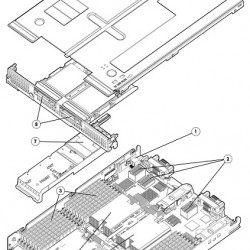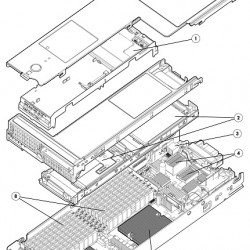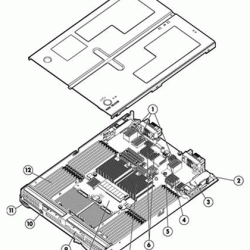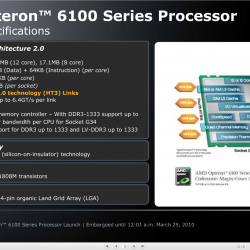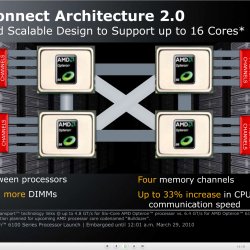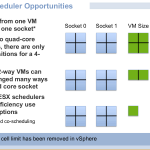UPDATED Yesterday when I woke up I had an email from Tolly in my inbox, describing a new report comparing the networking performance of the Cisco UCS vs the HP c Class blade systems. Both readers of the blog know I haven’t been a fan of Cisco for a long time(about 10 years, since I first started learning about the alternatives), and I’m a big fan of HP c Class (again never used it, but planning on it). So as you could imagine I couldn’t resist what it said considering the amount of hype that Cisco has managed to generate for their new systems(the sheer number of blog posts about it make me feel sick at times).
I learned a couple things from the report that I did not know about UCS before (I often times just write their solutions off since they have a track record of under performance, over price and needless complexity).
The first was that the switching fabric is external to the enclosure, so if two blades want to talk to each other that traffic must leave the chassis in order to do so, an interesting concept which can have significant performance and cost implications.
The second is that the current UCS design is 50% oversubscribed, which is what this report targets as a significant weakness of the UCS vs the HP c Class.
The mid plane design of the c7000 chassis is something that HP is pretty proud of(for good reason), capable of 160Gbps full duplex to every slot, totaling more than 5 Terrabits of fabric, they couldn’t help but take shots at IBM’s blade system and comment on how it is oversubscribed and how you have to be careful in how you configure the system based on that oversubscription when I talked to them last year.
This c7000 fabric is far faster than most high end chassis Ethernet switches, and should allow fairly transparent migration to 40Gbps ethernet when the standard arrives for those that need it. In fact HP already has 40Gbps Infiniband modules available for c Class.
The test involved six blades from each solution, when testing throughput of four blades both solutions performed similarly(UCS was 0.76Gbit faster). Add two more blades and start jacking up the bandwidth requirements. HP c Class scales linerally as the traffic goes up, UCS seems to scale lineraly in the opposite direction. End result is with 60Gbit of traffic being requested(6 blades @ 10Gbps), HP c Class managed to choke out 53.65Gbps, and Cisco UCS managed to cough up a mere 27.37Gbps. On UCS, pushing six blades at max performance actually resulted in less performance than four blades at max performance, significantly less. Illustrating serious weaknesses in the QoS on the system(again big surprise!).
The report mentions putting Cisco UCS in a special QoS mode for the test because without this mode performance was even worse. There is only 80Gbps of fabric available for use on the UCS(4x10Gbps full duplex). You can get a second fabric module for UCS but it cannot be used for active traffic, only as a backup.
UPDATE – A kind fellow over at Cisco took notice of our little blog here(thanks!!) and wanted to correct what they say is a bad test on the part of Tolly, apparently Tolly didn’t realize that the fabrics could be used in active-active(maybe that complexity thing rearing it’s head I don’t know). But in the end I believe the test results are still valid, just at an incorrect scale. Each blade requires 20Gbps of full duplex fabric in order to be non blocking throughout. The Cisco UCS chassis provides for 80Gbps of full duplex fabric, allowing 4 blades to be non blocking. HP by contrast allows up to three dual port Flex10 adapters per half height server which requires 120Gbps of full duplex fabric to support at line rate. Given each slot supports 160Gbps of fabric, you could get another adapter in there but I suspect there isn’t enough real estate on the blade to connect the adapter! I’m sure 120Gbps of ethernet on a single half height blade is way overkill, but if it doesn’t radically increase the cost of the system, as a techie myself I do like the fact that the capacity is there to grow into.
Things get a little more complicated when you start talking about non blocking internal fabric(between blades) and the rest of the network, since HP designs their switches to support 16 blades, and Cisco designs their fabric modules to support 8. You can see by the picture of the Flex10 switch that there are 8 uplink ports on it, not 16, but it’s pretty obvious that is due to space constraints because the switch is half width. END UPDATE
The point I am trying to make here isn’t so much the fact that HP’s architecture is superior to that of Cisco’s. It’s not that HP is faster than Cisco. It’s the fact that HP is not oversubscribed and Cisco is. In a world where we have had non blocking switch fabrics for nearly 15 years it is disgraceful that a vendor would have a solution where six servers cannot talk to each other without being blocked. I have operated 48-port gigabit swtiches which have 256 gigabits of switching fabric, that is more than enough for 48 systems to talk to each other in a non blocking way. There are 10Gbps switches that have 500-800 gigabits of switching fabric allowing 32-48 systems to talk to each other in a non blocking way. These aren’t exactly expensive solutions either. That’s not even considering the higher end backplane and midplane based system that run into the multiple terrabits of switching fabrics connecting hundreds of systems at line rates.
I would expect such a poor design to come from a second tier vendor, not a vendor that has a history of making networking gear for blade switches for several manufacturers for several years.
So say take it worst case, what if you want completely non blocking fabric from each and every system? For me I am looking to HP c Class and 10Gbs Virtual Connect mainly for inttra chassis communication within the vSphere environment. In this situation with a cheap configuration on HP, you are oversubscribed 2:1 when talking outside of the chassis. For most situations this is probably fine, but say that wasn’t good enough for you. Well you can fix it by installing two more 10Gbps switches on the chassis (each switch has 8x10GbE uplinks). That will give you 32x10Gbps uplink ports enough for 16 blades each having 2x10Gbps connections. All line rate, non blocking throughout the system. That is 320 Gigabits vs 80 Gigabits available on Cisco UCS.
HP doesn’t stop there, with 4x10Gbps switches you’ve only used up half of the available I/O slots on the c7000 enclosure, can we say 640 Gigabits of total non-blocking ethernet throughput vs 80 gigabits on UCS(single chassis for both) ? I mean for those fans of running vSphere over NFS, you could install vSphere on a USB stick or SD card and dedicate the rest of the I/O slots to networking if you really need that much throughput.
Of course this costs more than being oversubscribed, the point is the customer can make this decision based on their own requirements, rather than having the limitation be designed into the system.
Now think about this limitation in a larger scale environment. Think about the vBlock again from that new EMC/Cisco/VMware alliance. Set aside the fact that it’s horribly overpriced(I think mostly due to EMC’s side). But this system is designed to be used in large scale service providers. That means unpredictable loads from unrelated customers running on a shared environment. Toss in vMotion and DRS, you could be asking for trouble when it comes to this oversubscription stuff, vMotion (as far as I know) relies entirely on CPU and memory usage. At some point I think it will take storage I/O into account as well. I haven’t heard of it taking into account network congestion, though in theory it’s possible. But it’s much better to just have a non blocking fabric to begin with, you will increase your utilization, efficiency, and allow you to sleep better at night.
Makes me wonder how does Data Center Ethernet (whatever it’s called this week?) hold up under these congestion conditions that the UCS suffers from? Lots of “smart” people spent a lot of time making Ethernet lossless only to design the hardware so that it will incur significant loss in transit. In my experience systems don’t behave in a predictable manor when storage is highly constrained.
I find it kind of ironic that a blade solution from the world’s largest networking company would be so crippled when it came to the network of the system. Again, not a big surprise to me, but there are a lot of Cisco kids out there I see that drink their koolaid without thinking twice, and of course I couldn’t resist to rag again on Cisco.
I won’t bother to mention the recent 10Gbps Cisco Nexus test results that show how easily you can cripple it’s performance as well(while other manufacturers perform properly at non-blocking line rates), maybe will save that for another blog entry.
Just think, there is more throughput available to a single slot in a HP c7000 chassis than there is available to the entire chassis on a UCS. If you give Cisco the benefit of the second fabric module, setting aside the fact you can’t use it in active-active, the HP c7000 enclosure has 32 times the throughput capacity of the Cisco UCS. That kind of performance gap even makes Cisco’s switches look bad by comparison.
